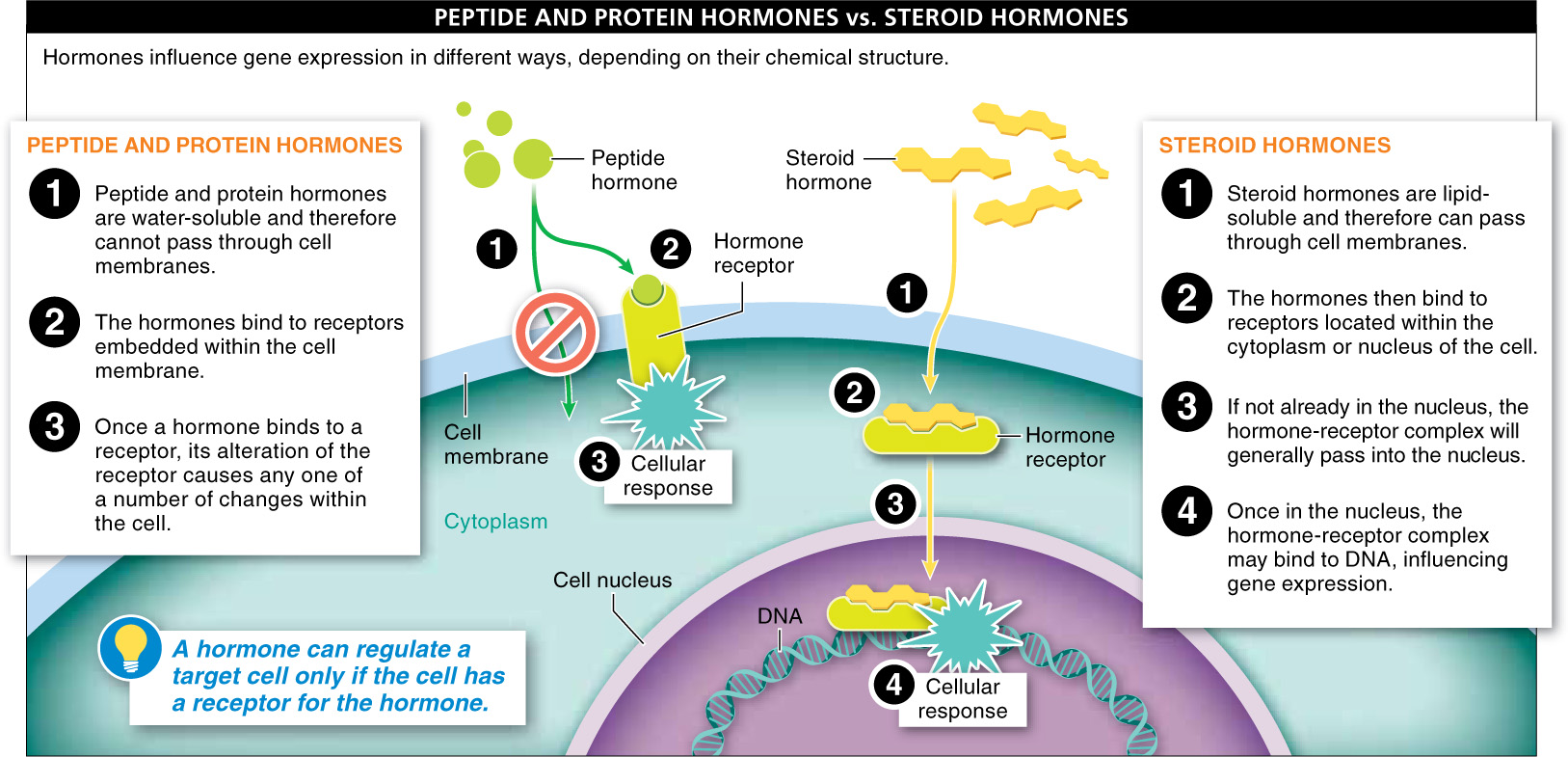If you turn on a radio, you can hear music. This is because, somewhere, a radio station is broadcasting a signal and your radio picks up that signal. If you turn the radio off, the music stops. The signal from the radio station, however, is still there. But without the proper receiver, the signal goes unnoticed. Hormones function much like radio signals. Glands produce and release hormones, which then make their way through the body, often distributed by the bloodstream, and bump into cells throughout the body. But, like a person without a radio, a cell doesn’t respond to a hormone unless it has a specific receptor for that hormone. The hormone may even diffuse right through a cell that has no intracellular receptors, without any effect.
There are dozens of hormones and even more ways that they regulate target tissues, but the general process by which hormones affect a particular cell doesn’t vary much.
- 1. Signal is sent. A hormone is released by a gland.
- 2. Signal is received. Although the hormone has no effect on most tissues it comes in contact with, cells with the proper receptor in their cytoplasm or on their plasma membrane receive the signal.
- 3. Cell responds. When the hormone binds to an appropriate receptor, it causes a response in the target cell. The response can be a change in gene expression in the target cell’s nucleus, which may cause the cell to start (or stop) producing a particular protein, or may alter the rate at which it produces the protein. A single hormone may cause different responses in different target cells.
Most hormones are one of two types: (1) the peptide and protein hormones (such as insulin), which are chains of amino acids, or (2) the steroid hormones (such as estrogen and testosterone), which are lipids, most of which are synthesized from cholesterol. Differences in the chemical structure of these two hormone types determine whether a hormone can pass through the cell membrane (FIGURE 24-5). Peptide and protein hormones, the most common type of hormones, are water-


974
The chemical structure of a hormone also determines how it regulates activity in a target tissue. For example, the receptors for peptide and protein hormones are embedded within, and extend through, cell membranes. Once a peptide or protein hormone binds to a receptor on the outside of the cell, it alters the receptor (perhaps changing its shape) and causes any one of a number of changes within the cell (into which the receptor extends). The hormone may activate an enzyme, initiating or speeding a reaction in the cell. Or it may alter the cell membrane’s permeability, facilitating absorption or secretion of certain molecules. Or it may alter proteins within the cell, causing them to move into the nucleus and bind directly to the DNA, influencing the rate of transcription of one or more genes (for example, turning the cell’s production of some protein products on or off).
Steroid hormones, on the other hand, pass through the cell membrane and bind to receptors in the cytoplasm or nucleus of target cells. If binding occurs in the cytoplasm, the hormone-
975
By traveling through the bloodstream, steroid hormones and peptide and protein hormones secreted by glands in one part of the body are able to regulate cell function in another part of the body. However, some glands produce regulators that act more locally. Called paracrine regulators, these molecules generally diffuse from the tissue in which they are produced into nearby tissue, binding to receptors on or in neighboring cells and influencing their activity. Prostaglandins are one of the most important and common groups of paracrine regulators, produced by almost every cell and nearly every organ in an animal’s body. Prostaglandins have numerous effects, such as causing dilation or constriction of blood vessels and affecting tissue inflammation.
Why might long-
One of the chief reasons that aspirin is such an effective pain reliever is that it inhibits an enzyme necessary for the production of prostaglandins (FIGURE 24-6). As a consequence, aspirin reduces inflammation (and the pain that often accompanies it)—but it also inhibits another, similar enzyme that is involved in maintaining the lining of the stomach. The development of the drug celecoxib, sold as Celebrex, has been hugely beneficial to people suffering from arthritis, who need regular, long-
TAKE-HOME MESSAGE 24.3
Hormones can regulate the activities of a target tissue only if the cells have a receptor specific to that hormone. Most hormones are either peptide and protein hormones, which cannot pass through cell membranes and so interact with receptors embedded in the membrane, or steroid hormones, which can diffuse through cell membranes, then interact with their receptors in the cytoplasm or nucleus of the target cell. Both types of hormones, once bound to a receptor, cause changes in the target cell, such as influencing the rate of transcription of genes.
Why can a receptor for a steroid hormone function in the nucleus of a target cell but a receptor for a protein hormone cannot?
Steroid hormones are lipid-soluble, meaning they can pass through the target cell's membrane and reach a receptor in the nucleus. Protein hormones are water-soluble; therefore, they cannot pass through the target cell's membrane. They can only bind to receptors embedded within the target cell's membrane.
976